The earth speaks an exotic and mysterious language. In place of syntax, soil expresses itself through minerals; for grammar, it relies on organic matter. It’s a fluid tongue, ever changing, but maintaining characteristics that long outlive the efforts of a single interpreter.
In metaphor, wine is a lexicography intent on compiling native dialects of specific plots of earth. Terroir is communication; the subtle interplay of dialogue between variety and soil. In a glass of wine, one does not exist independent of the other. New world wines label by grape—you know that it’s a Pinot Noir before you know it’s from Russian River. French wines, with centuries of trial and error, do not need to; variety is a given and codified by law. A Burgundy will label by region, by estate, by climat and even by lieu-dit, which may be as small as a few rows of vines.
In Burgundy, the vigneron says, “It is not just Pinot Noir; it is this Pinot Noir.”
| Pinot Noir is to its wild ancestors what an Irish Setter is to a wolf. One of the first of the domesticated cultivars, mention of it as a wine grape dates to the thirteenth century when it was known as ‘Moreillon.’ With Pinot Noir as a parent, more than 21 unique varieties have emerged, mostly through spontaneous crossings; they include Sauvignon Blanc, Cabernet Sauvignon and Burgundy’s other keystone, Chardonnay. In addition, over 500 Pinot Noir clones exist.
A thin-skinned grape that tends to bud early in the growing season, Pinot Noir is susceptible to extremes of cold and heat, and vineyards in which it excels tend to be sunny but cool. Then again, too much sunlight shrivels the thin skins and frost can quickly decimate crops, and even in Goldilocks conditions, yields tend to be low.
And yet, despite all the drawbacks, finicky Pinot Noir is responsible for some of the priciest, most enigmatic wines that humankind has ever produced. |
|
Pinot Noir: Earth’s Interpreter
|
|
| Cistercian monks of the Middle Ages were the first to grasp Pinot Noir’s unique ability to transmit terroir. So transparent is Pinot Noir’s reflection of location that it is function as a conduit, and this is one of the reasons it is rarely found in an assemblage, even where blending is legally permitted.
It is among the most aromatic of red wine grapes, and this quality is vital to its ability to mirror origin: German research in the early part of this century revealed a more pronounced link between soil and aroma than soil and taste. Terroir is genuine, in other words, but shows up in the nose more than the palate. The same study underscored the science that winemakers know from experience: Vines grown amid slate showed citrus notes; Basalt soils produced richer fruit flavors and smoother acidity; Limestone lent itself to more intense color and Sandstone showed mineral characters on the nose.
That different vineyard sites can produce markedly different wines was recognized long ago, and that some are unquestionably superior formed the foundation of the Burgundian cru system. |
|
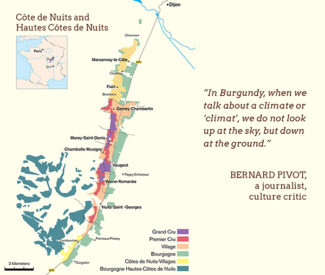
Gevrey-Chambertin: Making Sense of The Landscape
|
|
| Location, location, location; within an undulating landscape, the finest sites in Gevrey-Chambertin are found along a belt in the Côte d’Or at elevations that range between 900 and 1200 feet. Snaking down this magical route, south of the village of Gevrey-Chambertin and ending at the outskirts of its neighbor Morey-Saint-Denis, nine Grand Cru vineyards can be found, more than any other village in the Côte de Nuits. Eight of them feature ‘Chambertin’ in their names, homage to Le Chambertin, the most respected among them. Each are entitled to wear their individual appellation on the label, and so do not bottle under the AOP ‘Gevrey-Chambertin.’ They also produce the world’s most exclusive and expensive Pinot Noirs.
Commanding slightly less prestige—and as a result, more reasonable price points—are the Premier Cru vineyards, of which Gevrey-Chambertin has 26. Some are located around the group of Grand Cru vineyards south of the village, while some are located together on a slope to the northwest. Below this in classification, and often in elevation as well, are village-level wines, of which Gevrey-Chambertin has more than any other appellation in the Côte de Nuits and in the Côte d’Or, second only to Beaune.
In Gevrey-Chambertin, Premiers Crus occupy the upper portion of the Côte at heights of averaging a thousand feet; they consist of shallow brown limestone soils. Below them, the appellation Village vines, sit on brown calcic or limey soils. With situations generally east and southeast, the vines also reap the benefit of marls covered with screes and red silt washed down from the plateau. These stony mixes offer the wine elegance, while the rich marls add body and firmness. |
|
Gevrey-Chambertin ‘Combe-aux-Moines’: Muscularity and Structure
|
|
| Half of the Premiers Crus in Gevrey-Chambertin are located within the Combe de Lavaux, a small valley that cuts into the Côte d’Or. This topography is ideal for maximizing Pinot Noir’s potential; it provides slopes with a southern exposure, ensuring the vines are exposed to sunlight for a large portion of the day to aid ripening. Conversely, it funnels a cold wind from the west into the vineyard area, slowing ripening and bringing about significant swings in diurnal temperature that preserves acidity.
The Premier Cru ‘Combe-aux-Moines’ vineyard is situated at the north end of Combe de Lavaux, next to the Premier Cru ‘Cazetiers’ vineyard. It faces south and offers soil high in chalk and clay content. |
|
The Truth About Old Wine: A Scented and Fugitive Soul
|
|
| The primary myth about wine is that it invariably improves with age; in fact, the number of wines that benefit from being kept beyond a year or two of the release date is extremely limited, and those that can become ever more nuanced and intriguing after a decade in the bottle is probably a fraction of 1%. The second myth is that you, as a consumer, prefer the subtle flavors of a mature wine more than the fruity immediacy the same wine when young.
Well-aged wine, particularly from Burgundy, may even be an acquired taste, and understanding it is certainly an exercise requiring the same patience it takes to cellar it.
Certainly, the Domaine Gallois Gevrey-Chambertin selections in this package have been sculpted by time and curated by a master sculptor, but no human intervention or winemaking technique has (or could) compare to the mysterious and enhancing effects of age. They display a true expression of terroir and specificity of site rather than general varietal characteristics, and the nexus of age and beauty within these wines is emblematic of what properly-aged Burgundy is capable of producing: a sublime blend of fruity and savory sensations. |
|
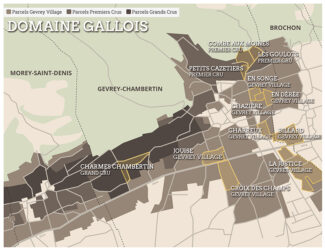
| Prior to taking over the family estate in 1989, Dominique Gallois studied catering in Paris and ran his own restaurant for six years. When he returned to Burgundy, the domain consisted of six acres in Gevrey-Chambertin which his father had managed for forty years, selling the grapes to négociants. Dominique began to renovate the property and in 1989 (after purchasing additional acreage in Combe aux Moines, Petits Cazetiers and Goulots) to bottle his own product, looking first to private customers to build a reputation. Recognizing that he works in terroir that is the envy of the world, Dominique takes special care to work the domain by hand, without pesticides or herbicides. Says Gallois, “Our year is quite full; winter months are dedicated to vine maintenance and Guyot-style pruning. During spring and summer, several tasks are performed allowing yields to be controlled and managing the healthiness of the future grapes. Harvesting is manual—we count on a small, faithful team to carry out the first sorting on the vine. Thereafter, grapes pass over a sorting table where bunches are inspected so as to conserve only the best fruit.” |
|
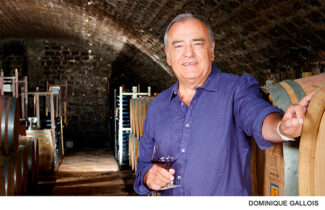
2016 Vintage: “Promising”
|
|
| After a series of short vintages, a warm winter and an early, vigorous bud burst left Burgundy with hopes of a bumper harvest, but those thoughts were short-lived: On April 26, a perfect storm of conditions—light rainfall followed by a sharp drop in temperature overnight, and a sunny morning that magnified the light through the prism of ice that had formed on the buds. Worst hit were the highest vineyards, often the most valued for quality; lower vineyards were shrouded in fog and somewhat protected.
Throughout the Côte d’Or, it was the most damaging frost since 1981.
In Gevrey-Chambertin, the higher-altitude vineyards close to the Combe de Lavaux (such as Les Veroilles, Poissenots, Lavaux Saint-Jacques and even Clos Saint-Jacques) suffered significant crop losses. Le Chambertin was pummeled, and lost two-thirds of its production.
As is often the case in reduced yields, the grapes that remained were concentrated and convey a strong impression of density. Ultimately, full phenolic ripeness was reached with Pinot Noir’s better examples characterized by wonderfully smooth tannins and showing a beautiful balance of fresh fruit, lively acidity and ripe tannins. |
|
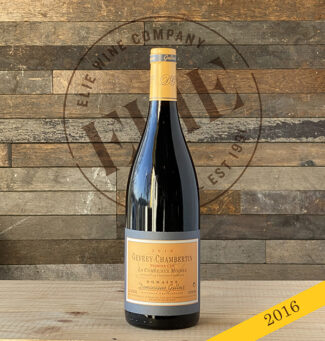 2016 Domaine Gallois Gevrey-Chambertin Premier Cru Combe-aux-Moines ($124)
2016 Domaine Gallois Gevrey-Chambertin Premier Cru Combe-aux-Moines ($124)
From a small parcel planted in 1952, the vines are steeply-sloped and east-facing, situated between 1100 and 1200 feet. Soil is shallow clay/limestone, and production is limited to around 2400 bottles.
The wine is rich ruby color with a bouquet of underbrush, black cherry, wild blackberry and licorice. It has evolved into a complex profile with nutmeg and leather up front, and damp earth and mocha making an appearance. Delightful now, but will continue to improve.
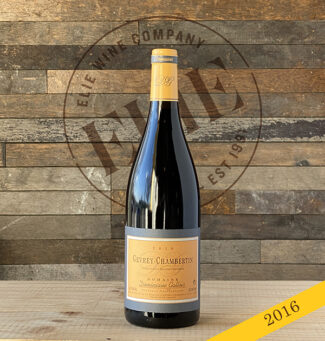 2016 Domaine Gallois Gevrey-Chambertin ($71)
2016 Domaine Gallois Gevrey-Chambertin ($71)
Gallois’ Gevrey-Chambertin Village is a cuvée of 10 climats: En Songe, En Jouise, En Billard, En Dérée, Croix des Champs, Sylvie, La Justice, Charreux, and two parcels of the clos surrounding the family home. Average age of vines from these different parcels is fifty years, and annual production is around 10,000 bottles.
A nicely layered wine with aromas of spicy cassis, cherries and rich soil tones.
2014 Vintage: “Surprising”
|
|
| Gevrey-Chambertin’s Pierre Damoy confessed his summertime blues: “Given that this was supposed to be an early vintage, the awful weather in August slowed everything down and caused us great anxiety.”
The cure was improved weather from mid-August onward, producing dry, sunny conditions that lasted well into September, giving the grapes a steady-state for maturation. The reds of the Côte de Nuits are said to be slightly less voluptuous than the giant vintages of 2009 and 2012, but riper than 2008, which had a similar growing season. |
|
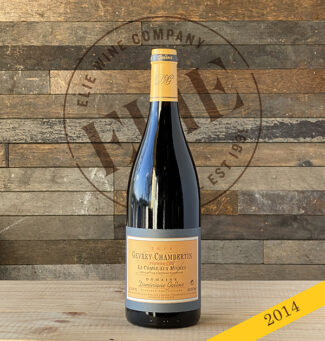 2014 Domaine Gallois Gevrey-Chambertin Premier Cru Combe-aux-Moines ($114)
2014 Domaine Gallois Gevrey-Chambertin Premier Cru Combe-aux-Moines ($114)
Linear, precise, rich and sumptuous, the wine shows nice notes of mulberry and smoke underscored by anise and an iron-rich minerality.
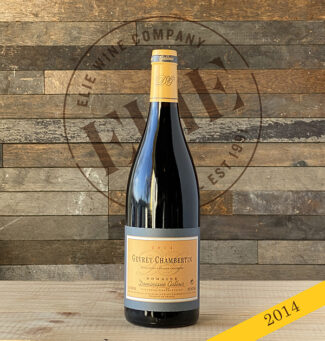 2014 Domaine Gallois Gevrey-Chambertin ($71)
2014 Domaine Gallois Gevrey-Chambertin ($71)
Solid and firm, balanced between fruit and savory with raspberries and red plums laced together with acidity, the iconic Gevrey-Chambertin earthiness and gripping tannins.
| A charitable overview of the 2013 vintage in Burgundy is to call it ‘complicated.’ Denis Bachelet of the eponymous Gevrey-Chambertin domain says, “The acidity of 2013 is not like 1996, which was created by a similar month of exceptionally cool wind and drought. In 2013 it was the three weeks immediately before the harvest which finally ripened the grapes, but because the harvest was so late, well into October for the reds – the days were shorter and cooler than usual resulting in higher acids in a very classical, typically Burgundian way.”
Despite the terrible flowering and disease pressure, Burgundy’s Pinot Noir crop wound up achieving full ripeness thanks to what turned out to be of the longest growing seasons on record. Aubert de Villaine of the Domaine de la Romanée-Conti admits, “Frankly, we were initially afraid of the 2013s. When we picked the grapes, we thought the wines would be much thinner than they have turned out, but since their first summer in cask they have become much more fruity and tender. Such difficult vintages can often be more interesting than the sunnier ones, which can sometimes leave their mark too strongly.” |
|
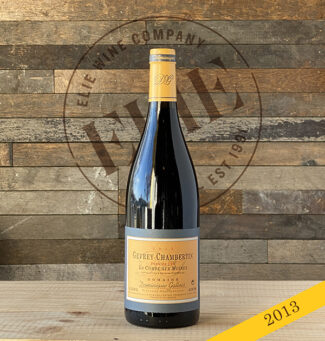 2013 Domaine Gallois Gevrey-Chambertin Premier Cru Combe-aux-Moines ($114)
2013 Domaine Gallois Gevrey-Chambertin Premier Cru Combe-aux-Moines ($114)
Extremely well-defined aromatics with blackberry, briar and limestone scents across the mid-palate, gaining intensity in the glass. Ripe, supple tannins with red cherries, wild strawberry and a touch of iron on the finish.
2012 Vintage: “Exceptional”
|
|
| It may be stated without argument that 2012 was tough on organic or fully biodynamic domains: A wet, cool spring brought some early frost, and steady rains led to a difficult flowering, which in some places took a month to complete. Extensive hail fell on June 6 followed by constant outbreaks of mildew, and although some growers could treat against them, estates that eschew such treatments could not.
Some growers in Gevrey-Chambertin reported losing half their crop, although the fruit that remained was concentrated and ripe. Sorting was a must, and the Pinot Noir-based wines have, for the most part, entered their optimum stage of drinkability. |
|
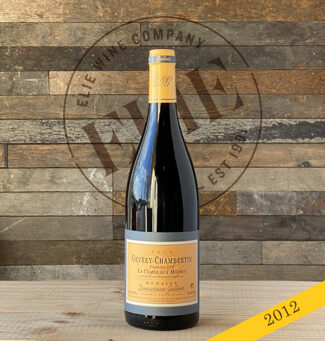 2012 Domaine Gallois Gevrey-Chambertin Premier Cru Combe-aux-Moines ($105)
2012 Domaine Gallois Gevrey-Chambertin Premier Cru Combe-aux-Moines ($105)
Having moved well beyond its youthful austerity, the wine is markedly cool with a nose that offers up notes of cassis, spice, earth, underbrush and menthol. A lovely mineral streak runs through the rich and relatively large-scaled flavors with excellent mid-palate concentration and a complex and impressively persistent finish.
- - -
Posted on 2022.03.12 in Gevrey-Chambertin, France, Wine-Aid Packages



 2016 Domaine Gallois Gevrey-Chambertin Premier Cru Combe-aux-Moines ($124)
2016 Domaine Gallois Gevrey-Chambertin Premier Cru Combe-aux-Moines ($124) 2016 Domaine Gallois Gevrey-Chambertin ($71)
2016 Domaine Gallois Gevrey-Chambertin ($71) 2014 Domaine Gallois Gevrey-Chambertin Premier Cru Combe-aux-Moines ($114)
2014 Domaine Gallois Gevrey-Chambertin Premier Cru Combe-aux-Moines ($114) 2014 Domaine Gallois Gevrey-Chambertin ($71)
2014 Domaine Gallois Gevrey-Chambertin ($71) 2013 Domaine Gallois Gevrey-Chambertin Premier Cru Combe-aux-Moines ($114)
2013 Domaine Gallois Gevrey-Chambertin Premier Cru Combe-aux-Moines ($114) 2012 Domaine Gallois Gevrey-Chambertin Premier Cru Combe-aux-Moines ($105)
2012 Domaine Gallois Gevrey-Chambertin Premier Cru Combe-aux-Moines ($105)


